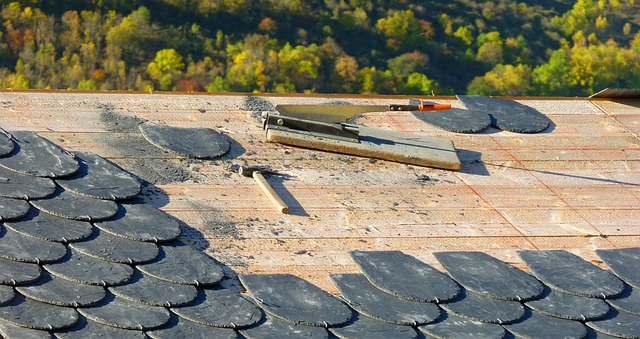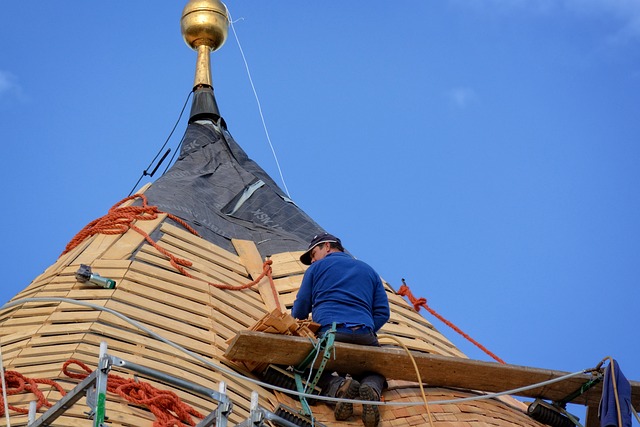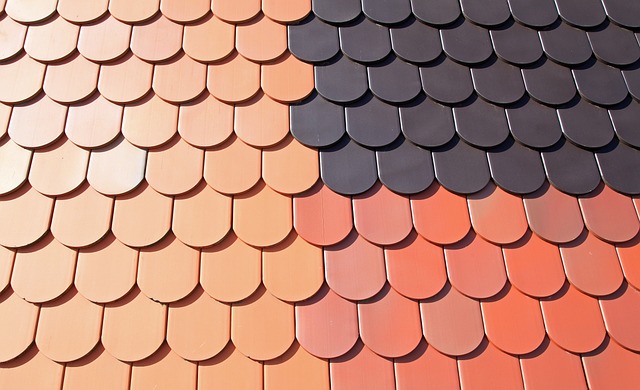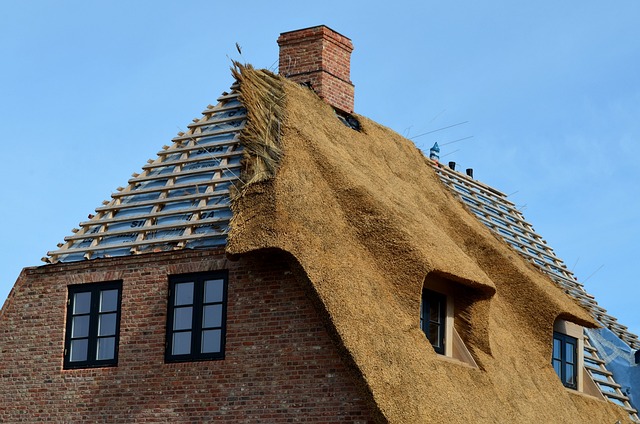In Springfield, Massachusetts, slate roofing from Slate Roofing Springfield MA stands out as a durable and visually striking option that can significantly enhance a property's value and appeal. Its long lifespan, enduring against various weather conditions, makes it a smart choice for the region's climate. Slate's resistance to freeze-thaw cycles, fire safety, and environmental benefits, including its natural abundance and recyclability, set it apart from other roofing materials. Homeowners are advised to perform bi-annual inspections, particularly after seasonal changes, to catch any signs of damage or wear, such as cracks or slate granules in gutters. Regular maintenance and professional assessments by local experts are essential for maintaining the integrity of slate roofs and preventing minor issues from escalating. In Springfield, MA, slate roofing's longevity is maximized through diligent care, ensuring it remains a robust and attractive feature for decades to come.
Slate roofing is synonymous with enduring charm and durability, a hallmark feature of many Springfield, MA homes. This article delves into the critical aspects of maintaining this resilient roofing type. We’ll explore the distinctive characteristics of slate roofing in Springfield’s unique climate, identify telltale signs of damage that can compromise its longevity, and underscore the necessity of regular inspections to ensure long-term integrity. With practical guidance for self-assessment and insights on professional intervention, readers will gain a comprehensive understanding of how to safeguard their slate roof investment against Springfield’s varied weather conditions. Slate Roofing Springfield MA is not just about installation; it’s about ongoing care that preserves the aesthetic and functional performance of your home’s roof for years to come.
- Understanding Slate Roofing Characteristics in Springfield, MA
- Visible Signs of Slate Roof Damage to Watch For
- The Importance of Regular Inspections for Slate Roofs in Springfield's Climate
- Step-by-Step Guide to Inspecting Your Slate Roof in Springfield, MA
- Professional Assessment: When to Call Experts for Slate Roof Repairs or Replacements
- Long-Term Maintenance Strategies for Maintaining Slate Roof Integrity in Springfield's Environment
Understanding Slate Roofing Characteristics in Springfield, MA

In Springfield, Massachusetts, slate roofing stands out for its durability and aesthetic appeal, making it a preferred choice for many homeowners seeking to enhance the value and visual charm of their properties. Slate Roofing Springfield MA is characterized by its natural slate tiles, which are prized for their longevity, often lasting over a century with proper maintenance. The local climate, with its varied seasons, can test the resilience of any roofing system, and slate proves to be exceptionally weather-resistant. It withstands the weight of heavy snowfalls typical in winter, ensures ventilation for moisture control in humid summers, and remains impervious to the freeze-thaw cycles that can damage other materials. The unique properties of slate make it an environmentally sustainable option, as it is a naturally abundant material that is both recyclable and non-combustible, offering superior fire safety compared to other roofing types. Understanding these characteristics is crucial for homeowners in Springfield MA, as they ensure long-term performance and cost-effectiveness of their slate roofing systems. Regular inspections by professionals well-versed in Slate Roofing Springfield MA can identify potential issues before they escalate, preserving the integrity and functionality of these high-quality roofs.
Visible Signs of Slate Roof Damage to Watch For

When assessing slate roofing in Springfield, MA, for damage, homeowners and professionals should be vigilant for several visible signs that indicate potential issues. One of the most apparent indicators is the presence of cracked or broken slates. These can be the result of severe weather events such as hailstorms, high winds, or heavy snowfall. Cracks may appear as fine lines or more pronounced fractures; either way, they compromise the integrity of the roof and should be addressed promptly. Additionally, watch for slate granules in the gutters or downspouts after a rainstorm, which can signify that the slates are deteriorating and may need replacing. Slate roofing is known for its longevity, but over time, natural wear and tear, along with environmental factors like freeze-thaw cycles, can cause slates to loosen or shift, potentially leading to leaks if not securely repositioned. It’s also crucial to inspect the underlayment and flashing around chimneys, vents, and valleys for any signs of water intrusion, as these are common points where leaks may originate. Regular maintenance and professional inspections can help prolong the life of slate roofing in Springfield, MA, and ensure that any damage is identified and corrected before it escalates into more significant problems.
The Importance of Regular Inspections for Slate Roofs in Springfield's Climate

In Springfield, Massachusetts, slate roofing stands as a testament to architectural integrity and durability, offering protection against the region’s diverse weather patterns. The climate in Springfield—with its mix of humid summers, cold winters, and occasional heavy precipitation—makes regular inspections of slate roofing essential for maintaining structural integrity and longevity. Slate Roofing Springfield MA is particularly vulnerable to the elements, and without diligent maintenance, even the most robust slate can succumb to wear over time. Homeowners in this region should prioritize bi-annual inspections to ensure that each slate tile remains secure, as loose or damaged slates can lead to leaks, water intrusion, and potentially significant structural damage. These checks allow for timely repairs, which are far less costly than extensive renovations required after neglected issues escalate. By scheduling professional assessments in spring and fall, when the weather is most agreeable, homeowners in Springfield can safeguard their property against the harsh conditions that slate roofs may face. This proactive approach not only preserves the aesthetic charm of Slate Roofing Springfield MA but also protects one of the region’s most valuable assets from the unpredictability of its climate.
Step-by-Step Guide to Inspecting Your Slate Roof in Springfield, MA

When spring arrives in Springfield, MA, it’s an opportune time to assess the condition of your slate roofing. A thorough inspection can catch issues early, ensuring the longevity and integrity of your home’s structure. Begin by safely accessing your roof using appropriate gear like a sturdy ladder, harness, and gloves to protect yourself from sharp edges and potential falls. As you survey the slates, look for any that appear cracked, chipped, or have slipped out of place. Pay particular attention to valleys, ridges, and the areas around chimneys or vents where water can pool and cause more significant damage over time. Note any slate irregularities as these can lead to leaks, which may not be immediately apparent from the inside of your home.
Next, examine the underlayment beneath the slates for signs of wear or saturation. The underlayment acts as a secondary barrier against water intrusion and its condition is crucial for maintaining the waterproofing of your roof. Additionally, check the flashing around vent pipes, chimneys, and skylights to ensure they are properly sealed and secure. Any rust spots or separations should be addressed promptly to prevent leaks that could cause further damage to your home’s interior. If you notice any issues during your inspection, it may be time to call in a professional roofer, particularly one with experience in slate roofing systems in Springfield, MA, to address the damage and perform any necessary repairs or maintenance. Regular inspections are key to preserving the beauty and durability of your slate roof for years to come.
Professional Assessment: When to Call Experts for Slate Roof Repairs or Replacements

When slate roofing adorns your property in Springfield, MA, it’s imperative to maintain its integrity due to its durability and aesthetic value. Regular inspections are crucial for early detection of potential issues, which can prevent larger problems down the line. However, not all damage is apparent to the untrained eye, and certain signs may indicate the need for professional assessment. If you notice cracked, chipped, or missing slates, it’s advisable to contact a specialist in slate roofing Springfield, MA. Professionals have the expertise to evaluate the extent of the damage and determine whether localized repairs or a complete replacement is necessary. They can also assess the underlayment and flashing conditions, as these components are equally vital for the roof’s overall performance. Furthermore, after severe weather events, it’s prudent to call in experts to ensure that no hidden damages have compromised the structural integrity of your slate roof. Their skills ensure that repairs are performed with precision, maintaining the original character and longevity of your slate roofing system in Springfield, MA. Regularly consulting with professionals for these assessments can extend the life of your slate roof and safeguard your home against water intrusion and other potential issues.
Long-Term Maintenance Strategies for Maintaining Slate Roof Integrity in Springfield's Environment

slate roofing Springfield MA is a resilient choice for homeowners looking to withstand the variable weather conditions of the region. To maintain the integrity of slate roofing in Springfield’s environment, which can range from harsh winters to hot, humid summers, long-term maintenance strategies are crucial. Firstly, bi-annual inspections should be scheduled after seasons of significant weather changes. These inspections aim to identify any loosened or broken slates, as well as check for signs of algae growth, which can compromise the slate’s protective surface. In Springfield’s environment, where tree cover is prevalent, regular cleanings to remove debris such as leaves and branches are essential to prevent moisture retention, which could lead to mold or moss growth, further threatening the roof’s structural integrity. Additionally, ensuring that gutters and downspouts are free of blockages contributes to the proper drainage necessary for maintaining the slate roofing in Springfield MA.
Furthermore, assessing the underlayment and flashing systems during these inspections is vital, as they act as a barrier against water penetration. If any compromised areas are found, immediate repairs are essential to prevent leaks that can cause significant damage over time. In Springfield, where temperature fluctuations can lead to freeze-thaw cycles, this proactive approach to maintenance becomes even more critical in preserving the longevity of slate roofing systems. Regular maintenance, including replacing any damaged slates and securing any that have shifted, will ensure that your slate roofing continues to protect your home effectively for decades to come. Engaging with local slate roofing experts in Springfield MA can provide personalized advice tailored to the specific challenges of the local climate, further enhancing the lifespan and performance of your slate roofing investment.
Slate roofing stands as a testament to enduring architectural elements within Springfield, MA. Regular inspections are key for maintaining the integrity of these roofs, particularly given the city’s climate variability. Homeowners should stay vigilant for signs of damage and heed professional advice when necessary. By following the outlined inspection process and committing to long-term maintenance strategies, slate roofing in Springfield can continue to offer its durability and aesthetic appeal. Investing in such care ensures that these roofs protect homes effectively, standing strong against the elements for years to come. For residents of Springfield, MA, understanding and proactively managing their slate roof systems is not just a matter of home maintenance but an integral part of preserving the city’s rich architectural heritage.
